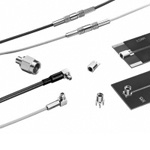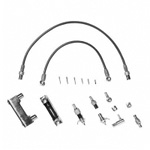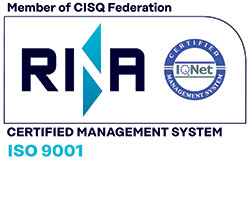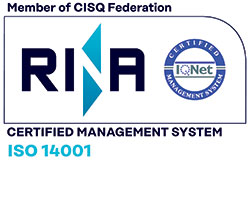Coaxial Connectors(M/N/O:Other)
| Shipping Days |
|
|---|
?* Information on days to ship and prices
-

MMCX Connectors
HIROSE ELECTRONIC
The MMCX connector is a small push-on lock coaxial connector.
[Features]
· Simple push-on format used for easy insertion and extraction.
· Able to load PCMCIA type II cards: MMCX-LR-SMT (40) have a thickness of 3.51 mm and can be loaded to the back side of type II cards.
· Moreover, if a 0.36 mm degree of eccentricity from the central card line is used when mounting a card on the circuit board mounting surface, the central card axis and central connector axis will be aligned.
· Ultra-thin cable compatibility: RG type high frequency coaxial cable... RG-178B/U (⌀1.8), ... RG-316/U (⌀2.59MAX), ⌀1.48 (single layer shield) fluorine resin coaxial cable, ⌀1.32 (double layer shield) ultra-thin fluoride resin coaxial cable, ⌀1.13 (single layer shield) ultra-thin fluoride resin coaxial cable, ⌀1.37 (single layer shield) ultra-thin fluoride resin coaxial cable.
· Dual terminal connection with other series: Capable of dual terminal connection with U.FL, N, BNC, HRM, and TNC series.
· Highly coordinated: high frequency traits are realized with a voltage standing wave ratio (V.S.W.R.) of less than 1.2 at a frequency of up to DC 6 GHz (possessing representative value and not compatible with all products).
・Compatibility: the opening is standard, allowing for mating with MMCX connectors.- Volume Discount
Configure nowStarting from∗ : 7.25 € Min. Shipping Days : 5 Days *Unit price with basic configuration
-

Small Slide-Snap Lock Coaxial Connector, MSS Series
HIROSE ELECTRONIC
Utilizing a slide snap lock method, both the internal and external conductors are in almost perfect contact, providing excellent durability. There are two types of wiring methods used: crimp wire connection and screw clamps. Compliant with Japan Defense Agency DSPC-6206.
[Features]
• The Japan Defense Agency has enacted a specifications document: DSPC-6206.
• Every aspect of performance for mid-size connectors is specifically demonstrated, and although the size is exceedingly miniaturized, performance is comparable to mid-sized high frequency connectors.
• A slide snap locking system is utilized within the external conductor, and this conductor has near complete contact and also demonstrates excellent vibration resistance.
• Wire connection work can be conducted in a thoroughly simplified and assured manner using one of these two methods: the crimp wire connection method or the screw clamp method.- Volume Discount
Configure nowStarting from∗ : 8.34 € Min. Shipping Days : 5 Days *Unit price with basic configuration
| Brand |
|---|
| Product Series |
| Starting from∗ |
| Min. Shipping Days |
| Connector Shape |
| A/B/C |
| D/E/F |
| G/H/I |
| M/N/O |
| S/T/U |
| Number |
| Applicable pin/contact |
| Number Of Cores |
| Application |
| Allowable Current(A) |
| Allowable Voltage(V) |
| Wire connection method |
| Connection direction |
| Protection function (environmentally resistant) |
| Impedance(Ω) |
| Representative Standard |
| Brand | HIROSE ELECTRONIC | HIROSE ELECTRONIC |
|---|---|---|
| Product Series | ||
| Starting from∗ | 7.25 € *Unit price with basic configuration Volume Discount | 8.34 € *Unit price with basic configuration Volume Discount |
| Min. Shipping Days | 5 Days | 5 Days |
| Connector Shape | Coaxial | Coaxial |
| A/B/C | - | - |
| D/E/F | - | - |
| G/H/I | - | - |
| M/N/O | Other | Other |
| S/T/U | - | - |
| Number | - | - |
| Applicable pin/contact | Male (plug) / Female (socket) | Male (plug) / Female (socket) |
| Number Of Cores | 1 | 1 |
| Application | Cable Connection / For PCB | Cable Connection / For PCB / Panel Mount |
| Allowable Current(A) | - | - |
| Allowable Voltage(V) | - | AC150Vrms |
| Wire connection method | Solder / Other | Solder |
| Connection direction | Straight / Angle | Straight / Angle |
| Protection function (environmentally resistant) | - | - |
| Impedance(Ω) | 50 | 50 |
| Representative Standard | - | - |
Loading...
Filter by:
-
Connector Shape
- Coaxial
-
A/B/C
- BNC
- Other
-
D/E/F
- Other
-
G/H/I
- Other
-
M/N/O
- MS
- N
- Other
-
S/T/U
- SMA
- SMB
- Other
-
Number
- Other
-
Applicable pin/contact
- Male (plug)
- Female (socket)
- Combination use male/female
- Other
-
Number Of Cores
-
Application
-
Allowable Current(A)
-
Allowable Voltage(V)
-
Wire connection method
- Solder
- Crimp
- Other
-
Connection direction
- Straight
- Angle
- Other
-
Protection function (environmentally resistant)
-
Impedance(Ω)
- 50
- 75
- Other
-
Representative Standard
Brand
-
- HIROSE ELECTRONIC (2)
- HUBER+SUHNER (0)
- YUETSU SEIKI (0)
- FUJIKURA (DDK) (0)
- TE CONNECTIVITY (0)
- KNIPEX (0)
- JAPAN AVIATION ELECTRONICS(JAE) (0)
- TO-CONNE (0)
- KASH (0)
- DENSAN (0)
- ECON CONNECT (0)
- BKL ELECTRONIC (0)
- SATO PARTS (0)
- CLIFF (0)
- TAJIMI ELECTRONICS (0)
- PHOENIX CONTACT (0)
- TRU COMPONENTS (0)
- NEUTRIK (0)
CAD data type
-
- 2D
- 3D










